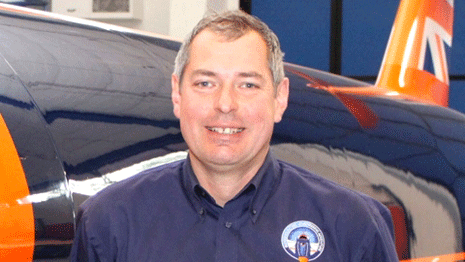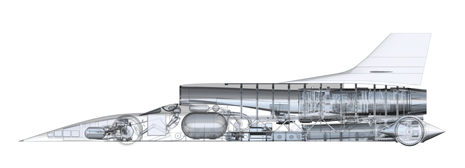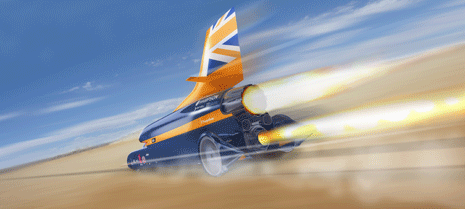
Mark Chapman has an enviable job as the chief engineer of the Bloodhound SuperSonic Car, a project launched in 2006 by Richard Noble with the aim of creating a jet and rocket powered car that could break the 1,000 mph world land speed record.
A few weeks back we featured a blog post about the new steering wheel challenge for the Bloodhound that has been launched by GrabCAD.
The challenge has passed and the judges, including our very own Al Dean, will be scrutinising the entries with the winner announced at the forthcoming Product Innovation Congress, which is taking place on 19 to 20 February in Berlin.
In the meantime, here is an interview with Chapman about the biggest engineering challenges they faced, how they are pushing the boundaries of technology, crowd sourced design and championing engineering as a career.

D3D: For a lot of your career you’ve worked in aeronautical engineering. Is this your first car project and how did you become involved in it?
Chapman: This is the first proper car project I’ve been involved with. I had a message left on my answerphone saying that a “mutual acquaintance had suggested I may be interested in being involved in a unique vehicle based project.” I went to a pub in Bristol and was shown a very early concept for the car and was hooked! That was five years ago – it is a once in a lifetime opportunity.
D3D: But then again the Bloodhound is not really a typical car project. Is a lot of what you’ve learnt in terms of propulsion systems and fluid dynamics transferrable to this project?
Chapman: Bloodhound is unique in that it’s part car, part jet fighter and a splash of spaceship. There are some aspects that are directly equivalent but it tends to be the combination of all three that keeps it interesting. Things like the fluid dynamics of flow around a shape at Mach 1.4 are well understood. However, in our case we’re doing the analysis in the proximity of a ground plane and that’s very different problem.

An image demonstrating the internals of the Bloodhound
D3D: What would you say has been the biggest engineering challenge of the Bloodhound SSC project?
Chapman: The trouble (or beauty) of Bloodhound is the challenges keep changing. Three years ago the biggest challenge was to come up with an external aerodynamic shape that was stable throughout the mach no. range. Top of the list currently are the front wheel brakes and managing the lateral stability of the car.
D3D: What is your favourite feature of the car and why?
Chapman: The airbrake mechanism, which is a very simple linkage that ensures the airbrakes open evenly and progressively. There’s a lot of thought that’s gone into it to make sure it’s robust enough and packages into a very limited envelope. Like much on the car it’s an original; aircraft tend not to deploy airbrakes around 800mph!

A cutaway of the car
D3D: The SSC project is pushing the boundaries of technology and engineering. Could you provide an example?
Chapman: Although we are very much a car, the scale and loads mean we push the boundaries. To put things in perspective, when we achieve 1000mph, we will also break the low altitude airspeed record. No aircraft has ever flown that fast at the height of the Hakskeenpan where we are running. In addition, as we are such a small design team we make much greater use of design techniques such as “Design of Experiments” and optimisation methods to get us close to a solution.
D3D: A number of sources have contributed to the design and engineering of the Bloodhound. Was this ‘crowd sourced design’ something you were keen to do?
Chapman: Definitely, it’s been an essential part of the design process. With the core design team being so small we’ve always looked to industry and academia to provide a wealth of ideas and experience that we as a project can draw upon and form into a cohesive design.
D3D: In terms of the GRABCAD competition, what criteria are you looking for in a steering wheel design?
Chapman: A really good, simple ergonomic design, and it’s always good to see something novel. The driver Andy Green won’t be spending much time looking in the cockpit, so a clear layout and differentiation of any switches and triggers is key. Also the loads Andy will put through the wheel can be large. On Thrust SSC, he managed to bend the steering column, so nothing too flimsy.

A rendering of what the cockpit could look like
D3D: How long until you race the car, and will you be there to see it?
Chapman: The plan is for the car to be completed this year and will be ready for installed engine tests in the autumn. Depending on the onset of the rains in South Africa we will either take it there straight after the UK runway testing, or early in 2014. Although the design and build of the car will be complete, most of the current team will also be coming to support the runs in South Africa – there are an awful lot of jobs to do!
D3D: Despite the challenge of breaking the world speed record, the Bloodhound project has really inspired young people and the interest in it has been huge. Do you feel proud of what you and the team have achieved?
Chapman: For us as a team, breaking the land speed record has been a secondary goal – our primary aim has always been to enthuse and inspire the next generation to be interested and excited by a technology based career. I’m very proud at how far we’ve come in the last few years, and I think we have shown our genuine commitment to this. But are always seeking to improve, and as we get close to running the car I’m hoping people will start to see a real change in how we are able to engage.
D3D: Lastly, there is a lack of young people who are taking up engineering as a career. What would you say to encourage them to study engineering?
Chapman: When I was at school no one championed what a great career engineering is. It is one of the few careers that is truly universal, the skills learnt are highly transferrable and there’s no reason to ever be bored. I have been lucky enough to work throughout Europe and North America on a wide range of projects from software development through to sewage works via planes and the odd supersonic car. There really is no limit as to where engineering can take you.







